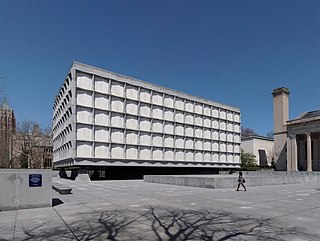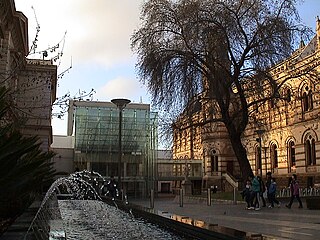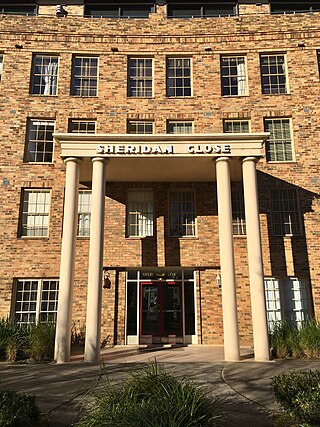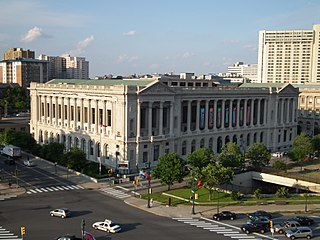
Sir Robert Gordon Menzies was an Australian politician and lawyer who served as the 12th prime minister of Australia from 1939 to 1941 and 1949 to 1966. He held office as the leader of the United Australia Party (UAP) in his first term, and subsequently as the inaugural leader of the Liberal Party of Australia, which he was responsible for establishing and defining in policy and political outreach. He is the longest-serving prime minister in Australian history.

The Beinecke Rare Book & Manuscript Library is the rare book library and literary archive of the Yale University Library in New Haven, Connecticut. It is one of the largest buildings in the world dedicated to rare books and manuscripts and is one of the largest collections of such texts. Established by a gift of the Beinecke family and given its own financial endowment, the library is financially independent from the university and is co-governed by the University Library and Yale Corporation.

The University of Melbourne is a public research university located in Melbourne, Australia. Founded in 1853, it is Australia's second oldest university and the oldest in Victoria. Its main campus is located in Parkville, an inner suburb north of Melbourne's central business district, with several other campuses located across Victoria.

State Library Victoria (SLV) is the state library of Victoria, Australia. Located in Melbourne, it was established in 1854 as the Melbourne Public Library, making it Australia's oldest public library and one of the first free libraries in the world. It is also Australia's busiest public library and, as of 2023, the third busiest library globally.

The National Library of Australia (NLA), formerly the Commonwealth National Library and Commonwealth Parliament Library, is the largest reference library in Australia, responsible under the terms of the National Library Act 1960 for "maintaining and developing a national collection of library material, including a comprehensive collection of library material relating to Australia and the Australian people", thus functioning as a national library. It is located in Parkes, Canberra, ACT.
The University of Sydney Library is the library system of the University of Sydney. It comprises eight locations across several campuses of the university. Its largest library, Fisher Library, is named after Thomas Fisher, an early benefactor.

The State Library of New South Wales, part of which is known as the Mitchell Library, is a large heritage-listed special collections, reference and research library open to the public and is one of the oldest libraries in Australia. Established in 1869 its collections date back to the Australian Subscription Library established in the colony of New South Wales in 1826. The library is located on the corner of Macquarie Street and Shakespeare Place, in the Sydney central business district adjacent to the Domain and the Royal Botanic Gardens, in the City of Sydney. The library is a member of the National and State Libraries Australia (NSLA) consortium.

Sidney Myer was a Belarusian-born Jewish-Australian businessman and philanthropist, best known for founding Myer, Australia's largest chain of department stores.

The University High School is a government-funded co-educational secondary day school, located in the Melbourne suburb of Parkville, Victoria, Australia. As of 2016, 1,425 students attended the school.

The State Library of South Australia, or SLSA, formerly known as the Public Library of South Australia, located on North Terrace, Adelaide, is the official library of the Australian state of South Australia. It is the largest public research library in the state, with a collection focus on South Australian information, being the repository of all printed and audiovisual material published in the state, as required by legal deposit legislation. It holds the "South Australiana" collection, which documents South Australia from pre-European settlement to the present day, as well as general reference material in a wide range of formats, including digital, film, sound and video recordings, photographs, and microfiche. Home access to many journals, newspapers and other resources online is available.

The Australian National University Library is part of the Australian National University in Canberra, one of the world's major research universities.

Kenneth Baillieu Myer, was an American-born Australian patron of the arts, humanities and sciences; diplomat, administrator, businessman and philanthropist. He was a member of the notable Melbourne retailing Myer family. Myer made significant philanthropic and personal contributions to the development of major national institutions, most notably the Howard Florey Laboratories of Experimental Physiology and Medicine, the School of Oriental Studies at the University of Melbourne, the Victorian Arts Centre and the National Library of Australia. In 1959, he became Benefactor and Co-Founder of The Myer Foundation with his brother Baillieu Myer AC. He was also the founding chairman of the Australian Broadcasting Corporation.

Melbourne Savage Club is a private Australian gentlemen's club founded in 1894 and named after the poet, Richard Savage. Bohemian in spirit, the club was to bring together literary men, and those immediately connected or sympathising with literature, the arts, sport or science. Its membership is particularly secretive with a strong code of silence; members are traditionally the elite or 'savages' in the arts, business and politics. Travelling savages enjoy good fellowship through reciprocal arrangements with other private clubs throughout the world.

The Federal Coffee Palace was a large, elaborate French Second Empire style 560 room temperance hotel in the city centre of Melbourne, Victoria, built between 1886 and 1888 at the height of Melbourne's 1880s land boom, and demolished in 1972-73. Located on Collins Street, Melbourne's premier thoroughfare, on the corner of King Street, near Spencer Street Station, it is prominent in lists of the buildings Melburnians most regret having lost.

Norma Redpath was a prominent Australian sculptor, who worked in Italy and Melbourne.
Ian Francis McLaren, F.R.H.S.V., was an Australian politician, accountant, businessman, historian, bibliographer and book-collector.

Sheridan Close is a low-rise apartment complex situated on 485–489 St Kilda Road, Melbourne, Victoria, Australia. It has direct access onto Fawkner Park at the rear of the building. It was designed by the architect Sir Bernard Evans, who later became Lord Mayor of Melbourne, and was built by Prentice Builders. Sheridan Close is described as "a stylistic hybrid", combining a concave regency façade, Georgian proportioned windows and Art Deco influences, with serrated side elevations to ensure views of St Kilda Road.

Parkway Central Library also known as Free Library or Central Library is the main public library building and administrative headquarters of the Free Library of Philadelphia system. It is the largest library, and only research library, of 54 library branches in the Free Library system.
Sun Books was an Australian publisher of paperback books, founded in Melbourne in 1965 by Geoffrey Dutton, Max Harris and Brian Stonier. Sun's three founders were all former employees of Penguin Australia who, having grown frustrated by the latter's tepid interest in home-grown content, had resigned in order to establish the imprint, envisioned as a publisher of “quality paperbacks for the sophisticated Australian reader”, and a platform for local literary talent. Prior to its acquisition by Macmillan in 1981, Sun had published over 330 titles, of which 187 were first editions.

Mannix Library is an academic theological library located in East Melbourne, Australia. The library specialises in the areas of theology, philosophy, biblical studies and associated disciplines, and supports teaching and research at Catholic Theological College and the wider University of Divinity. The student body includes candidates for ordination, lay men and women, undergraduate, postgraduate and higher degree by research students, and members of the general public. The library uses OCLC's World Share Management System.






















